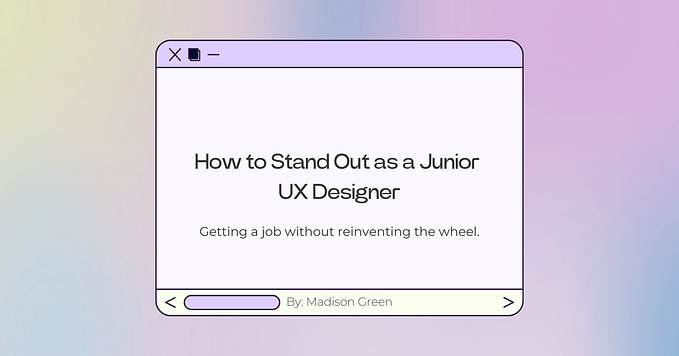Core principles for product designers

The pain point
As a designer working in an incubator lab alongside researchers, engineers, product managers, and stakeholders to build new digital products, it’s clear that there is an opportunity for design to take a bigger role in the overall product development. To further infiltrate design into the base of any project I think we need to re-structure the role of designers and the way teams are built. In the digital product design space, there are a variety of design roles that create unnecessary points when ideas and context must be shared amongst the design team between members with different skill sets. Designers are increasingly being forced to pick a road towards being in a role when they are required to primarily strategize and troubleshoot or in a role where the visual aesthetic takes the forefront and are not involved with the preliminary strategies, user needs or stakeholder goals. This is a problem and I believe it stems in part on how the role and skillset of a designer is misinterpreted by other professionals that collaborate with design but primarily amongst designers themselves.
What can we do?
The Bauhaus created a revolution in how design should be taught and executed by encouraging that each designer possess the skills of various creative disciplines. Unfortunately, the industry has been taking a step backward by dividing the different areas of the design practice into specific roles. This has lead to multiple design teams within one design team and designers that identify with a single discipline. I have heard UX designers claim they aren’t creatives, and visual designers say they aren’t interested in the strategy and research. There are obvious issues to that thinking but one of the main problems is that it completely ignores the symbiotic relationship that occurs during the entire design process. Providing value and a good experience to humans doesn’t stop at the feature level, it doesn’t stop at the wireframes it doesn’t stop at the illustrations. The best way to ensure the initial spark of a product turns into a flame and reaches the final touchpoint with a user, the same designers need to be involved from beginning to end to ensure the vision, context, and thinking are holistically applied to the whole design process as each step informs and supports the next.
So how does this actually translate into day to day skills and work for the design team?
The idea is that there would be a stronger emphasis on core skills with fundamentals in design thinking, strategy, UX, visual design, and an understanding of design theory as well as the fundamentals of their chosen design discipline(view chart). For example, the idea is that a design team tasked with building products would only have product designers who would all possess skills in user experience design and visual design. They would have the skills to design UI one minute and become an investigator the next as soon as changes in the product arise as they often do. The goal is that during each step of the process, every member will have the available skills to be present when features change, design reviews amongst researchers and engineers, and be able to fight for good UX and UI. Every designer on the team should possess some basic research skills, for example when designing the UI of any product having the ability to research accessible colors palettes, user behaviors regarding UI, available mental models, various typefaces and their impact on legibility, will significantly improve the UX of a product but in some cases aren’t covered during the UX process. This model will still include junior to senior roles but the idea is that even at the junior level designers will have the opportunities and fundamentals to be involved from the very beginning till the end. This idea doesn’t just apply to digital product design either, this can be applied to a variety of design teams, from apparel to branding, to industrial design all with their corresponding fundamental skills that go beyond mastering either just the visual or the practical. Designers should be able to problem solve at every step of the project. The goal is that designers are viewed as experts in designing experiences for people, not just creating visuals or translating features into a flow.

How we will get there?
Design already has the necessary disciplines to contribute at each stage, the key is that each designer should practice those disciplines. Practices like strategy, user experience, research, collaboration, psychology, communication, as well as other soft skills, and very importantly the processes of design thinking should be part of every designer’s tool kit. The goal is that if each member has the same core principles the collaboration will continue from beginning to end with a consistent vision and each member able to contribute both to elevating the level of design but also to defend and explain it throughout the entire process. A great place to start developing these skills should be at the design education level. Ideally, student’s education would have an emphasis on craft, problem solving, and empathy as well as how to apply those skills in a variety of design practices. The goal is that design and its full capabilities are introduced at the very beginning of a designer’s relationship with the practice. That they understand how design is beyond focusing on visuals, focusing on aesthetic, focusing on strategy and that the holistic application of all those elements is what makes design great. The goal would be to show the beauty that exists in a well thought out site map and the pure function in a great UI. Of course a formal education is not the only way as many people learn in variety of other formats. For professionals taking online courses, collaborating with coworkers or simply practicing during the after hours is a great place to start and besides its important to always keep growing even as pros.
To conclude
Every product designer must have design thinking as their core skill with the ability to focus on user needs, pain points, empathy, visual design, typography, and the list goes on. Possessing and applying these skills will add further significance and value to a design team’s role in the world of innovation, lead to value creation for humans, and push the roles and responsibilities of designers everywhere.








